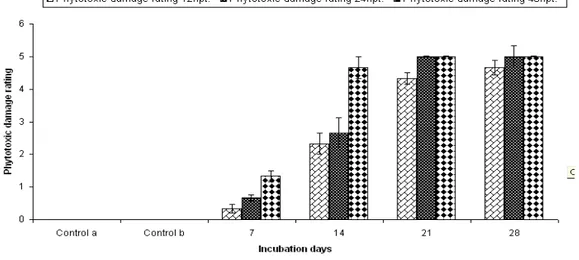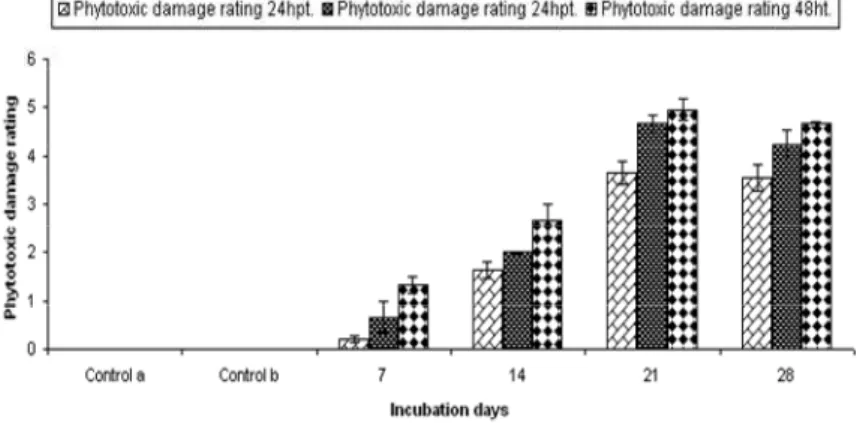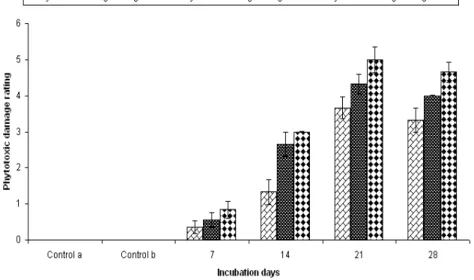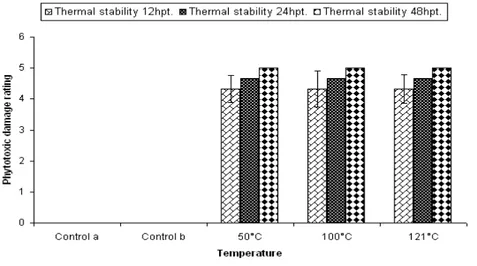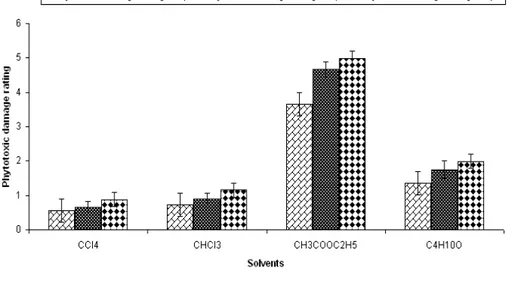BRAZILIAN ARCHIVES OF BIOLOGY AND TECHNOLOGY
Vol.53, n. 3: pp. 669-678, May-June 2010 10.1590/S1516-89132010000300023
ISSN 1516-8913 Printed in Brazil
A N I N T E R N A T I O N A L J O U R N A L
Production
and
Extraction
of
Phytotoxins
from
Colletotrichum dematium FGCC# 20 Effective Against
Parthenium hysterophorus L.
Jaya Singh,
Sadaf Quereshi
*, Nikita Banerjee and Akhilesh Kumar Pandey
Mycology Research Laboratory; Department of Biological Sciences; R.D. University; Jabalpur (M.P.) - India
ABSTRACT
The aim of this work was to study the herbicidal potential of Cell free culture filtrate of Colletotrichum dematium FGCC#20 against Parthenium by employing different bioassays i.e. shoot-cut, seedling, detached leaf and seed germination. On solvent extraction of the Cell free culture filtrate, Ethyl acetate extracted fraction showed the presence of phytotoxic moiety.
Key words: Parthenium hysterophorus; Colletotrichum dematium; bioassay; Cell Free Culture Filtrate (CFCF);
solvent extraction; hours post treatment (hpt)
*Author for correspondence: sadaf2577@gmail.com
INTRODUCTION
Parthenium hysterophorus L., popularly known as carrot weed or congress grass, native of West Indies, Central and North America was possibly introduced in India along with food grain imported under PL 480 scheme (Rao, 1956). Being an aggressive annual weed of disturbed sites, within the last three decades, it has established itself in the country and during the last few years; it has spread in almost all the states of the country. It is somewhat an unattractive member of Asteraceae. It is included in world’s worst weeds. Different parts of the plant including pollen of the weed exert alleleopathic effect on agricultural crops. Two sesquiterpene lactones such as parthenin and coronopilin exert allelopathic effect on agricultural crops (Deshpande et al., 2005). It also adversely affects human and animal health (Narsimhan et al.,
1977).
Colletotrichum spp. are well known fungal pathogens, which cause severe diseases in a variety of plants. Many Colletotrichum species cause plant diseases commonly known as anthracnose on stems, leaves and fruits of a range of economically important plants, such as cereal crops, grasses, legumes, fruits and vegetables, and species of perennials. Strains of this pathogen are important model systems in bioherbicide studies and are expected to have the ability to meet some of critical agronomic needs once constraints are overcome.
It is well-documented that species produces phytotoxic metabolites which induce the symptoms similar to those of the pathogens themselves. Some of the metabolites have been used to select for resistance and have been shown to play a significant role in pathogenesis. C.
subsp. angustifolium (family Onagraceae) has been investigated on biological weed control (Garcia-Pajon and Collado, 2003). It produces large necrotic lesions on the leaves and stem of the infected plant. Two C-6 and C-8 methylflavonols were isolated from ethyl acetate extracts of liquid culture filtrates of the fungus. These demonstrated a high degree of antimicrobial and phytotoxic activity (Gohbara et al., 1978). These avoid the environmental problems as encountered by the use of chemicals.
Phytotoxins have not received extensive testing for their use as synergists of biocontrol agents. Thus, there is a need to study the weed pathogens, phytotoxins produced by them and their integration with biocontrol agents for a holistic approach for an integrated weed management. Looking into these challenges and world over emphasis towards developing ‘environment friendly’ technologies to avoid the hazards of chemicals, non-biodegradable pesticides and pollutants, the present approach could be a promising technology.
MATERIAL AND METHODS
Strain
Strain of Colletotrichum dematium FGCC # 20 was obtained from Fungal Germplasm Culture Collection (FGCC), Mycological Research Laboratory, Department of Biological Sciences, R.D.V.V. Jabalpur (M.P.) India. The culture was maintained on Potato Dextrose Agar (PDA); pH-6.0 medium at 4 ± 10C; light: 2.5x104erg/cm2/s in a refrigerator for further studies.
Morphological study
Slide culture and Camera Lucida (Line Drawings) were used to study the morphological characteristics of fungal strain and identification was done with the help of standard literature.
Preparation of Cell free culture filtrate (CFCF) Fermentation
Richard’s medium (Agarwal and Hasija, 1986) containing KNO3-10 g, KH2PO4-5 g, MgSO4. 7H2O.-2.8g, Sucrose-35g, FeCl3-Trace, distilled water-1000ml; pH-3.84 ± 1 was used for the fermentation. Ten mycelial bits (2.5mm) separated from seven days old culture of the fungus grown on PDA medium at 26 ± 20C were transferred to 1000ml Erlenmeyer flasks containing 500 ml
medium. Inoculated flasks were incubated at 26 ± 20C; light intensity 3.5x104erg/cm2/s in B.O.D. incubator (Remi, India) for 7, 14, 21 and 28 days.
Extraction of CFCF
CFCF was aseptically obtained by filtering the metabolized growth medium through pre – weighed Whatman fillter paper No. 1. The supernatant was filtered through the filter paper 0.25 m (Sartorius), under in vacuo conditions (Walker and Templeton, 1978).
Bioassays
Following bioassays were performed to assay the phytotoxicity of fungal CFCF against Parthenium.
Detached leaf bioassay
Parthenium leaves detached from the plant were surface sterilized with 0.2% NaOCl and were incubated in a sterilized moist filter paper in Petri plates using cotton and filter paper under continuous fluorescent light at 28 ± 10C. The phytotoxic effect due to the application of toxin was observed after 24, 48 and 72 hpt at room temperature (Sharma et al., 2004).
Shoot cut bioassay
Shoots (15 - 20 cm in length) were taken and tip of the shoots were sterilized by washing with tap water and with 0.1% NaOCl solution for 3 minutes and immediately washed in sterilized distilled water to remove any trace of the chemical. An inclined cut was made at the tip and the shoots were dipped in different dilutions of the filtrate. Different days old CFCF viz., 7, 14, 21 and 28 days and different concentrations, i.e. 25, 50, 75 and 100% of CFCF were prepared using sterile Distilled water. The effect of dilutions of the toxic metabolites was observed on the shoots after 24, 48, and 72 hpt at room temperature.
Seedling Bioassay
The seedlings were raised in plastic pots containing soil, sand and peat in the ratio (1:1:1). The culture filtrates were sprayed to run off and incubated for different periods. Observation regarding the toxicity of the seedlings were made regularly (Abbas et al., 1995; Abbas and Boyette, 1992).
Seed germination bioassay
CCl4 layer Concentrated at
400C
CFCF extracted with CCl4
Seeds were picked up randomly, dipped first in 0.01% NaOCl solution for 15 minutes, then dipped in toxin of different days old CFCF and different concentrations of CFCF and finally washed thoroughly with distilled water. Seeds were incubated in CFCF for overnight and placed in moist chamber. Plates were incubated at 26 ± 20C in B.O.D. incubator. Seed germination percent was recorded after seven days. Seeds incubated in sterilized distilled water served as control (Singh and Pandey, 2001; Thapar et al., 2002).
The unmetabolized growth medium (Richard’s) and distilled water were taken as control a and control b. The experiment was carried out in triplicate respectively.
Thermal stability of phytotoxin
To ascertain the mode of extraction of the phytotoxic moiety, it was extremely essential to determine the thermal nature of phytotoxin (s). For this, 50 and 100% concentrations of CFCF of C. dematium was subjected to different temperature
treatment viz. 50, 100 and 1210C (autoclaved). Each treatment was carried out for 15 mins. The phytotoxic activity of each treatment was assessed using the shoot cut bioassay (Siddaramaiah et al.,
1979) and detached leaf bioassay (Sharma et al.,
2004).Each treatment was carried out in triplicate and CFCF at room temperature served as control and uninoculated medium served as second control.
Organic solvent extraction
Phytotoxins were extracted from the broth of 21 days old culture of C. dematium FGCC#20 grown as stationary culture (28 ± 2oC; 0.25 L batches) on Richard’s broth. The CFCF was obtained as described earlier and concentrated to 1/50 folds of the original volume. Solvents used were carbon tetrachloride, chloroform, ethyl acetate and butanol. Concentrated CFCF was further subjected to organic solvent extraction scheme as shown below:
Assessment of the biological activity
All layers were subjected to in vacuo dessication at 40oC in a rotatary vacuum evaporator (Buchi, Germany) to remove the solvent and to obtain the
residues. Residues were named as Fraction A (carbon tetrachloride). Fraction B (chloroform). Fraction C (ethyl acetate), Fraction D (butanol). The test residues were prepared as stocks using
Fraction-1
Insoluble layer Extracted with Chloroform
(1:1v/v)
Ethyl acetate soluble layer
Concentrated at 400
C
Insoluble layer Butanol Extracted with
(1:1v/v)
Butanol soluble layer
Concentrated at 400C
Chloroform layer concentrated at 40
0 C
Insoluble layer Extracted with ethyl
distilled water and were tested for their phytotoxic activity using detached leaf bioassay (Strobel, 1973; Karr et al., 1974).
RESULTS
Shoot cut bioassay
As evident from Figure 1, when shoots of test weed Parthenium were immersed in different days old CFCF of the test fungal strain, phytotoxic damage occurred which was observed after 12, 24
and 48hpt. The 21 days old fermented broth exhibited maximum phytotoxic damage to the
Parthenium shoots after 48h, followed by 28, 14 and 7 days old CFCF. There existed a direct relationship between different days old CFCF and hpt of treatment with toxin. Phytotoxic effect was less after 12hpt and mild at 24hpt but was maximum at 48hpt. The shoots exhibited blackening of stem, drooping and curling of leaves, severe chlorosis and necrosis, finally leading to death of the toxin treated shoots.
Figure 1 - Effect of different days old CFCF of C. dematium on Parthenium shoots.
Seedling bioassay
Phytotoxic damage rating was determined on
Parthenium seedlings by spraying the CFCF of different incubation days of C. dematium FGCC# 20. When shoot cut bioassay was performed with different concentrations of 21 days old CFCF of C. dematium FGCC# 20, Maximum damage rating was observed after 48 hpt with 100% concentration of CFCF followed by 75 and 50%. Negligible effect was observed by 25% concentration. The results are documented in Fig 2.
Fig 3 shows that 21 days old CFCF imparted
maximum damage to the seedlings after 72h, followed by 48 and 24hpt of spraying with 28, 14 and 7days.
Figure 2 - Effect of different days old CFCF of C. dematium on Parthenium seedlings by Seedling Bioassay.
Figure 3 - Effect of different concentrations of 21 days old CFCF of C. dematium by Shoot cut
Biossay.
Figure 4 - Effect of different concentrations of 21 day old CFCF of C. dematium by Seedling
Detached leaf bioassay
Detached leaf bioassay was performed by treating
Parthenium leaves with different day’s old metabolized broth. Shown in Fig 5 clearly indicated that 21 and 28 days old CFCF brought maximum phytotoxic damage followed by 14 and 7 days old metabolized medium. In general effect was less after 12 hpt and gradually enhanced till 48 hpt.
Results on the treatment of detached leaves with increasing concentrations of 21 days old fermented medium is shown in Fig 6. Maximum damage was observed after 48 hpt with 100% CFCF of C. dematium FGCC# 20. In general, toxin treated leaves showed slight chlorosis, which increased with incubation time, leading to severe chlorosis, necrosis and complete death of leaf.
Figure 5 - Effect of different days old CFCF on Detached leaf Biossay.
Figure 6 - Effect of different concetrantions of 21 day old CFCF of C. dematium by Detached leaf
Biossay.
Seed germination bioassay
Results after the treatment of the seeds of
Parthenium with toxins produced by C. dematium
FGCC# 20 at different concentrations are
germination observed with 75 and 100% was too negligible indicating nearly 90% inhibition of seed germination. Thus, the seeds imbibed the phytotoxin from C. dematium FGCC# 20 at higher concentration, hampering the germination.
Thermal stability
Data presented in Fig 8 showed that the phytotoxicity of fermented broth of C. dematium
FGCC# 20 did not change and was stable at 50, 100 and 121oC.
Figure 7 - Effect of different concentrations of 21 days old CFCF of C. dematium on Seed
germination Biossay.
Figure 8 - Determination of thermostability of CFCF of C. dematium by Detached leaf Biossay.
Isolation of phytotoxin(s) Solvent extraction
As depicted in Fig 9 the following results are: a. Fraction A (carbon tetrachloride fraction) was white in appearance. It produced least phytotoxic damage to Parthenium leaves even after 48 hpt.
b. Fraction B (chloroform fraction) was yellow in appearance. It also failed to produce significant phytotoxicity on Parthenium leaves at either 12, 24 or 48 hpt.
chlorosis and necrosis on the leaves of test weed as early as 12 hpt. The Damage increased gradually and reached to its maximum after 48 hpt, ultimately leading to death of leaves after 48 hpt. d. Fraction D (butanol fraction) was pure white powder in appearance and produced phytotoxic effects on Parthenium leaves as severe chlorosis, necrosis after 48 hpt.
The order of phytotoxicity of solvent extracted fractions was ethyl acetate >butanol > chloroform > carbon tetrachloride.
The phytotoxic moiety was present in ethyl acetate extracted fraction.
Stastistics
Each experiment was performed atleast three times. The data are given in figures as Mean ±SE and the bars denote ±S.E. values. Data were analyzed by Analysis of Variance (ANOVA) Genstat, Hyderabad, India with a significant level of (P=0.05)
Figure 9 - Effect of different solvent extracted fractions of the CFCF of C. dematium on Detached
eaves of Parthenium.
DISCUSSION
Variations in phytotoxicity with different days and different concentrations have been reported by earlier workers (Pandey et al., 2004, 2005; Quereshi et al., 2006; Quereshi and Pandey, 2007; Shukla and Pandey, 2006, Thapar et al., 2002). Observations regarding the phytotoxic damage rating on treatment with different days old metabolized broth and 21 days old CFCF of different concentrations on test weed seedlings have been reported by Joseph et al. (2002) which strengthen the present data. Similar results on detached leaf bioassay have been obtained by Sharma et al (2004). Thapar and Singh (2003) studied the effect of leachates of Amaranthus viridis on Parthenium weed. Jeyalakshmi et al.
(1998) carried out a study indicating CFCF of
Trichoderma sp. exerting inhibitory effect on seed
germination of Parthenium. Similarly observations regarding thermo-stability of phytotoxic moiety have also been made by Siddaramaiah et al.
(1979). Kurian et al. (1977) also recorded thermostable and non-proteinous nature of toxin produced by Cristulariapyrimidalis. Barbosa et al. (2002) reported similar results regarding thermostability of phytotoxin produced by
Bipolaris euphorbiae effective against the weed
organic solvent (Benzene, Chloroform or ethyl acetate) prior to purification. Tenuazonic acid was extracted from CFCF of A. alternata by employing ethyl acetate (Robeson and Jalal, 1991). Similarly, Yoshida et al. (2000) isolated toxic compounds from the CFCF of C. dematium by fractionating it with an equivalent volume of n- hexane and ethyl acetate.
The biological control of the weeds with microorganisms has provided an effective and eco- friendly management for many weed problems. Thus, the main aim of this paper was to highlight the herbicidal efficacy of the phytotoxins of C. dematium FGCC#20 as novel and lucrative source of potential herbicides for the management of weed, Partheniumhysterophorus and the presence of the phytotoxic compounds in ethyl acetate extracted fraction.
ACKNOWLEDGEMENT
The authors are thankful to the Head, Department of Biological Sciences, R.D. University Jabalpur, for laboratory facilities. University Grants Commission, New Delhi and Madhya Pradesh Biotechnology Council, Bhopal are also thankfully acknowledged for providing financial assistance.
REFERENCES
Abbas, H. K. and Boyette, C. D. (1992), Phytotoxicity of Fumonisin B, on weed and crop spp. Weed Technol.,6, 548-543.
Abbas, H. K., Boyette, C. D. and Hoagland, R. E. (1995), Phytotoxicity of Fusarium, other fungal isolates, and of the phytotoxins fumonisin, fusaric acid, and moniliformin to jimsonweed. Phytoprotect.,
76, 17–25.
Agarwal, G.P. and Hasija, S.K. (1986), Microorganisms in the laboratory - a laboratory guide of mycology, microbiology and plant pathology. Print House (India) Lucknow, pp. 155.
Barbosa, A. M., Souza, C. G. M., Dekker, R. F. H., Fonseca, R.C. and Ferreira, D.T. (2002), Phytotoxin produced by Bipolaris euphorbiae in vitro is effective against the weed Euphorbia heterophylla. Braz. Arch. Biol. Technol., 45 (2), 233-240.
Deshpande, V.K., Patil, B. Shivashankaragouda, Kivadasannavar, P.B. (2005). Allelopathic effect of
Parthenium extract on seed quality of vegetables. In: Proc. Second International conference on Parthenium
management, UAS, Bangalore, 5-7 Dec’05, pp.229-234.
Garcia-Pajon, C.M. and Collado, I.G. (2003), Secondary metabolites from Colletotrichum species.
Nat. Prod. Rep., 20, 426-431.
Gohbara, M., Kosuge, Y., Yamasaki, S., Kimura, Y., Suzuki, A. and Tamura, S. (1978), Isolation, structure and biological activities of Colletotrichins, phytotoxic substances from Colletotrichum nicotianae. Agric. Biol. Chem., 42, 1037-1043.
Jeyalakshmi, S. D. and V. Valluvaparidasan. (2004), Selection of fungal pathogens for managing
Parthenium weed. J. Mycol. Pl. Pathol., 34, 492-496. Joseph, S., S. Lal. and Pandey, A.K. (2002),
Preliminary evaluation of herbicidal potential of
Streptomyces sp. WC# 150 against Lantana camara. Ann Pl Protec., Sci. 10, 134-136.
Karr, A.L. Jr., Karr, D. B. and Strobel, G.A.(1974), Isolation and partial characterization of four host specific toxins of Helminthosporium maydis (race T.).
Pl. Physiol., 53, 250-257.
Kurian, P., Stelzig, D.A., Baniecki, J.F. and Marshall, M. (1977), Toxin production by Cristullariella pyramidalis. Mycologia., 69 (6), 1203-1206.
Narsimhan, T.R., Ananth, M., Narayana Swamy, M., Rajendra Babu, M. and Subba Rao P.V. (1977), Toxicity of Parthenium hysterophorus.Curr. Sci., 46, 15-16.
Pandey, A.K., Chandla, Poonam. and Rajak, R.C. (2002), Herbicidal potential of Secondary metabolites of some fungi against Lantana camara. J. Mycol. Pl. Pathol., 32, 100-102.
Pandey, A.K., Singh, A.K, Quereshi, Sadaf and Pandey, C. (2005), Herbicidal Activities of Secondary Metabolites of Aspergillus sp. against Lantana camara. J. Basic Appl. Mycol., 4 (I and II), 65-67. Pandey, A.K., Singh, A.K. Quereshi, S. and Agrawal,
D. (2004), Herbicidal activities of secondary metabolites of Strepomyces sp. against Hyptis suaveolens. J. Basic. Appl. Mycol., 3, 95-97.
Quereshi Sadaf., Pandey, A.K., Singh, A.K., Yadav, K.K. (2006), Herbicidal potential of Phoma sp. FACC#54. A preliminary evaluation. J. Basic Appl. Mycol., 5 (I and II), 60–61.
Quereshi, S. and Pandey, A. K. (2007), Evaluation of the secondary metabolites of Phoma sp Test strain#54 for management of Parthenium hysterophorus. Indian Phytopathol.,60 (4), 462-466 Rao, R.S. (1956), Parthenium hysterophorus L., a new record for India. J. Bombay Nat. Hist. Soc., 54, 218-220.
Robeson, D.J., Jalal, M. A. F. (1991), Tenuazonic acid produced by an Alternaria alternata isolate from Beta vulgaris. J. Inorg. Biochem., 44, 109-116
Shukla, R. and Pandey, A.K. (2006), Maximization of production oxalic acid form Sclerotium rolfsii, a mycoherbicidal agent against Parthenium. Ann. Pl. Protect. Sci.,14 (1), 202-205.
Siddaramaiah, A.L., R.K. Hedge, S. Kulkarni and A.B. Basvarajaiah. (1979), Toxic effect of the culture filtrates of Phaeophelospora indica.. Indian Phytopathol., 32, 291.
Singh, J. and A.K. Pandey (2001), Incidence of storage mycoflora associated with some forest plants of ethnic values in M.P. Ind. J. Appl. Pure. Biol., 16
(1),43-45.
Strobel, G.A. (1973), The Helminthosporoside binding protein of sugarcane. J.Biol.Chem., 248, 1321-1328. Thapar R. and Singh, N.B. (2003), Allelopathic effects
of Amaranthus viridis on Parthenium hysterophorus.
J.Ind.Bot.Soc., 82, 93-96.
Thapar, Riti., Singh, A.K., Pandey, Archana and Pandey, A. K. (2002), Bioactivity of CFCF of
Curvularia lunata in Partheniumhysterophorus L. J. Basic Appl. Mycol., 1, 126-129.
Vikrant, P., Verma, K.K., Rajak, R.C. and Pandey, A.K. (2006), Characterization of a phytotoxin from Phoma herbarum for management of Parthenium hysterophorus L. J. Phytopathol.,154, 1-8.
Walker, H.L. and Templeton, G. E. (1978), In vitro
production of phytotoxic metabolites by
Colletotrichum gleosporoides f sp aeschynomene.
Plant Sci Lett.,13, 91-99.
Yoshida, S., Hiradate, S., Fujii, Y. and Shirata, A. (2000), Colletotrichum dematium produces phytotoxins in anthracnose lesions of mulberry leaves. Amer. Phytopathol. Soc., 90 (3), 285-291.
